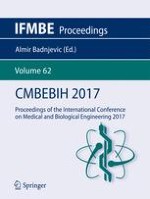2017 | OriginalPaper | Buchkapitel
FEA of the transiliacal internal fixator as an osteosynthesis of pelvic ring fractures
verfasst von : Dominik Jungtäubl, Paul Schmitz, Simon Gross, Sebastian Dendorfer
Erschienen in: CMBEBIH 2017
Verlag: Springer Singapore
Aktivieren Sie unsere intelligente Suche, um passende Fachinhalte oder Patente zu finden.
Wählen Sie Textabschnitte aus um mit Künstlicher Intelligenz passenden Patente zu finden. powered by
Markieren Sie Textabschnitte, um KI-gestützt weitere passende Inhalte zu finden. powered by
Common Schanz screw systems can be used to stabilize pelvic ring fractures. In order to accommodate for different patient’s requirements, implants can be placed in cranio-caudal direction into the os ilium (T1), or into the supraacetabular bone canal, and thus, in dorso-ventral direction (T2). Whereas both techniques are currently used, no data of the biomechanical behavior is available up to this date. The aim of this study is to analyze, whether T2 shows biomechanical advantages with respect to tissue and implant stresses due to the enlarged bone-implant interface. Forces acting on the pelvis were analyzed using motion capture data of a gait cycle obtained by the utilization of a musculoskeletal simulation program. A three dimensional finite element (FE) model of the pelvis with grayscale-based material properties was generated. The muscle and joint reaction forces at toe-off were applied to the FE model and instable pelvis fractures were implemented. The osteosynthesis systems were positioned within the model in order to enable the comparison between the two different surgical techniques. Stresses and displacements were analyzed for bone tissue, fracture zone and implant.T2 lead to approx. 30% larger displacements in the fracture zone. Von-Mises stresses were larger for T2 in the implant (80 MPa vs. 227 MPa), whereas T1 leads to larger stresses in the bone tissue (200 MPa vs. 140 MPa).Both implantation techniques showed a good biomechanical behavior. Differences could be found with respect to tissue strains and deformations in the fracture zone. If bone quality or fracture healing are of concern, T2 or T1 should be used, respectively. However, both techniques seem to be applicable for cases with no special requirements. Further analyses aim to investigate the behavior under cyclic loading.
